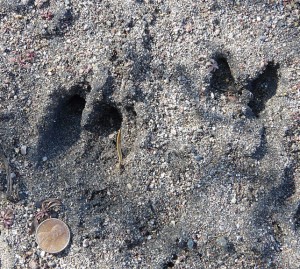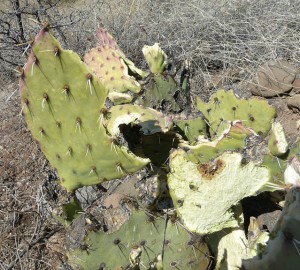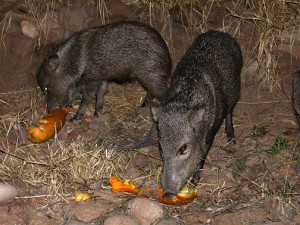
This morning I went out for a walk along the Big Tree Trail with our two English Springer Spaniels, Bower (age 4) and Chloe (age 2). Just as we came out of the woods to cross Bear Creek on our return to the Casitas, we suddenly came upon a small group of adult Javelina with young ones in tow. I suppose they were as startled by our sudden appearance as we were startled of them. In any case, Bower let out a woof or two and started towards them to investigate, with Chloe following. But as soon as he saw what they were, he quickly decided that really wasn’t such a good idea and came running back, with Chloe fast behind. (For all his bravado as a great hunter, Bower is finally beginning to display some instinctual adult sense. Plus, we have taken great pains to train both Bower and Chloe not to bother the Javelina, Mule Deer, Rocky Mountain Bighorn Sheep, and, very importantly, rattlesnakes. Most unfortunately, however, he, unlike Chloe, still hasn’t learned to leave the Striped Skunks alone.) Anyway, we took a little detour around the Javelina family as they continued foraging their way down the creek, and returned to the Casitas.

Javelina (Pecari tajacu), or as known elsewhere in the Western Hemisphere by their other common name, the Collard Peccary, are one of the most interesting animals commonly found in the Casitas de Gila Nature Preserve. They are native to and are found abundantly throughout the Southwest U.S., as well as in Central and South America. In size they are about that of a medium-sized dog, adults weighing up to 40 or 60 pounds. They are easily recognized by their large, tapered and triangular-shaped head with a rubbery pig-like snout, a heavy coat of coarse, salt-and-peppered gray and black hair in adults (brownish to reddish in juveniles), and a lean, muscular body mounted on short, spindly legs with two toes in front and three in back. In appearance, they also bear considerable resemblance to the wild razorback hog or feral domestic pig of the Southern U.S., which originated in Europe, and with which they are sometimes confused.

The Javelinas here at Casitas de Gila Guesthouses are generally found in small family bands or herds of up to 15 or so individuals. While they do feed on insects, reptiles and worms, their preferred diet consists of all types of plant material, including roots, grass, seeds, and fruits which they find in abundance along the Bear Creek floodplain and harvest readily with four straight canine tusks, which in adults are about 2 inches long. Amazingly, one of their favorite foods is the Prickly Pear Cactus, a plant that is covered with needle-like spines up to 2 or 3 inches long! I personally can vouch for this being true, since the flowering Prickly Pear is one of my favorite desert subjects to paint. Over the years every one I have used as a painting subject has been eaten by a roving band of Javelinas after my painting was finished.
Javelina have notoriously poor distant eyesight, which they make up for by having a good sense of hearing and smell. They have a strong scent gland located on their rump with which they mark their territory and fellow herd members. Unmolested they are not aggressive, and will quickly leave the scene when humans appear. Occasionally, however, and if forced to, they will defend their territory, usually with much grunting and gnashing of tusks as a warning, especially when there are babies or young ones present. Woe be unto the dog that chooses to chase them! When this happens, typically several adults in the herd will almost always become very aggressive, and, as a result, the dog generally comes running straight to its owner with all the javelinas chasing after. Definitely not good.
The best time and place to see the Javelinas at Casitas de Gila Guesthouses is early in the morning or in the afternoon down along Bear Creek where food is most dependable. Less commonly, they will be found on the hills adjacent to Bear Creek when they are hankering for a good feed on Prickly Pear Cactus. Once the days start getting hot, they are rarely out and about from mid-morning to late afternoon, preferring instead to find a nice shady spot for a siesta, and then becoming active once again during the cool evening hours.

For a few years right after we opened we used to have the Javelinas right at the doorstep. This occurred when we decided it would be a nice touch to have pumpkins around the Casitas and at the office between Halloween and Thanksgiving. It’s hard to say what the guests thought of our efforts, but the Javelinas loved the pumpkins! The night-time sounds of chomping incisors and grunting and fighting over the pumpkins became an annual event, as the Javelina very quickly noted the date of the Great Pumpkin Feast on their calendar. So we had to give it up. Much better to have those critters down by the creek rather than up at the Casitas.
For the last half of 2010, and so far this year, the climate for the Western Hemisphere has been dominated by the presence of strong La Niña conditions in the Eastern Pacific. When this occurs, winters in Southwest New Mexico tend to be dry and cool, and this year is no exception. Presently, in our area most upland sources of water are in the process of drying up, or have already dried up, and are unlikely to be replenished until the Monsoon Rain Season begins in late June or early July. At the Casitas, however, Bear Creek runs year ’round. As a result, during the dry seasons increased numbers of animals and birds come to the area around Casitas de Gila and Bear Creek because of the dependable availability of water. If the current dry conditions continue into Spring, and in all likelihood they will, the number of furry and feathered visitors to the floodplain below the Casitas should increase. Judging by the number and variety of tracks in the trails along the floodplain over the past couple of weeks, this certainly seems to be the case, and right now the two-toed tracks of the Javelina can be seen everywhere!


